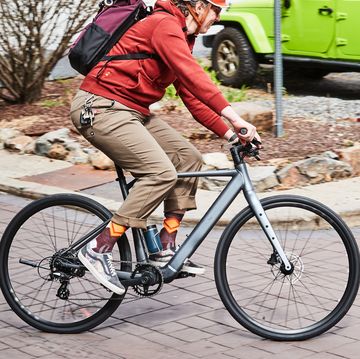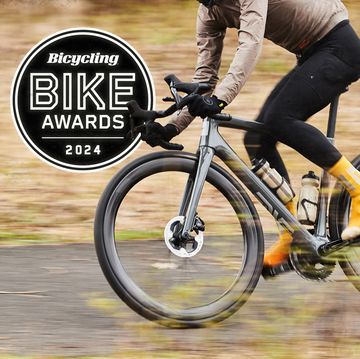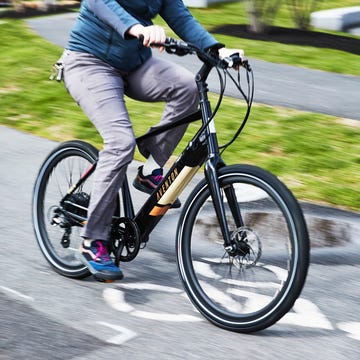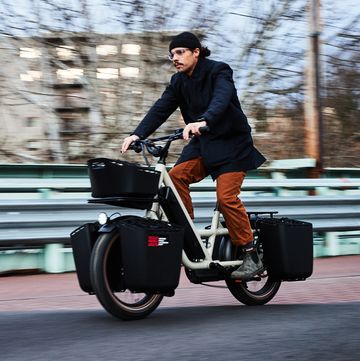With more than 880,000 e-bikes sold in 2021 and researchers projecting sales will continue to soar, it’s clear electric bikes are rising in popularity. Many cyclists utilize them in some capacity, either as a form of transportation, exercise, or both, yet some of us still don’t quite understand how riding an electric-powered bike can offer health benefits similar to a conventional bike.
The beauty of e-bikes: You still gain many of the health benefits you get from conventional cycling, just with a little boost. Here, all the e-bike health benefits you’ll gain when you start riding with an assist.
The Health Benefits of Riding an E-bike
1. Betters Brain Health
Riding an e-bike can help elevate your mood—and it doesn’t take a ton of time for that to happen. A study published in PLOS One found that after eight weeks of riding three times a week for 30 minutes each ride, e-bike riders improved their reaction times, executive function (which involves the ability to plan, focus, and juggle multiple projects), and self-reported mental health. Researchers found these benefits for both regular cyclists and e-bike riders, but said that e-bikers may experience even greater benefits.
“We have found that people just enjoy [e-bikes]. They say they are fun, and that can have positive effects on your overall well being,” says Jennifer Dill, Ph.D., a professor of urban studies and planning and director of the Transportation Research and Education Center at Portland State University.
Other research confirms riding e-bikes can be mentally beneficial for older adults who are adjusting to the aging process or those who have neurological issues, she adds.
In one small study published in Disability and Rehabilitation, stroke survivors mentioned e-bikes helped them increase physical activity levels despite having some level of physical impairment (like having to ride with one hand), because the pedal assistance improved their confidence to cycle for longer and farther. Though researchers noted larger scale studies are needed to recommend e-bikes as a form of rehabilitation for stroke survivors, these observations prove e-bikes can help bridge the gap to physical activity for some patients.
2. Improves Joint Health
Many people fall in love with cycling because it’s a low-impact sport, which means you’ll feel less pressure on your joints (hips, knees, and ankles), then you would if doing a high-impact activity, like running or jumping.
When running, your body can experience a force anywhere between three to five times your bodyweight upon landing, says Melissa Gallatin, P.T., physical therapist and medical endurance team lead at The Ohio State University. “If you have knee osteoarthritis, that places more pressure on the joint, versus just pedaling, which there’s not so much of that impact,” she says. “It can build the muscles around the joint without having the trauma of the impact.”
3. Aids Recovery
Riding an e-bike is a great way to modify and monitor your recovery as you return to cycling post-injury, Gallatin says. “If you’re recovering from an injury, for example, patellofemoral pain, you’re supposed to avoid a lot of uphill climbs. So if you’re out on your bike, if you run into an uphill climb, you can kick the e-bike in and take the stress off that quad, so that it’s not overworking and allow it to recover,” she explains.
Also, going for an easy ride on an e-bike can aid your recovery after an intense workout. “It’ll take some of the stress off, so that you’re not overworking the muscles, but you’re getting joint movement, and circulation to help with any type of lactic acid buildup,” Gallatin says. Research confirms the benefits of light physical activity to help your muscles recover.
A ride on an e-bike might also help you stick to the lower-intensity training zone you want to maintain for recovery rides between hard workout days.
4. Keeps Physical Activity Levels Up
Riding an e-bike will get your heart rate up so you can reach your activity goals each week. The CDC recommends 150 minutes of moderate-intensity physical activity (plus, two days of strength training).
“We know that when you’re riding an e-bike, it is lower intensity when you’re using that electric assist. But the research has found that people still are in that range of moderate-to-vigorous physical activity, which is what the health recommendations are for adults,” says Dill.
Also, e-bike riders tend to ride for longer and maintain activity levels comparable to conventional cyclists, Dill says. In fact, one study, published in 2022 in Transportation Research in Interdisciplinary Perspectives, surveyed more than 10,000 e-bike and conventional riders to find e-bike cyclists averaged more miles per trip, 5.8 miles, compared to conventional cyclists, who averaged 2.9 miles.
What’s more: The study found that many riders aren’t trading in their conventional bikes for e-bikes, but instead, they are utilizing both. So if you have an e-bike, or are looking to invest in one, this just means you’ll likely increase your activity levels even more. Plus, you can still get your heart rate up and get in a great workout when you ride an e-bike.
5. Boost Overall Health
In addition to getting you to move more and clock more miles, e-bikes also improve your overall well-being. According to a systematic review and meta-analysis, published in 2022 in Frontiers in Sports and Active Living, researchers found that e-bike riding can boost your VO2 max, a marker of your aerobic fitness level. Because of this, researchers say the activity can improve your health and decrease the risk of early mortality, as better aerobic fitness is tied to better health outcomes.
While we need more research on how e-biking benefits specific health parameters—like blood pressure and cholesterol levels—getting in more physical activity has plenty of benefits for your general wellbeing, with little downsides.

Monique LeBrun joined the editorial staff in October 2021 as the associate health and fitness editor. She has a master’s degree in journalism and has previously worked for ABC news and Scholastic. She is an avid runner who loves spending time outside.













